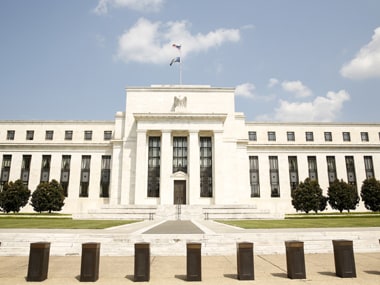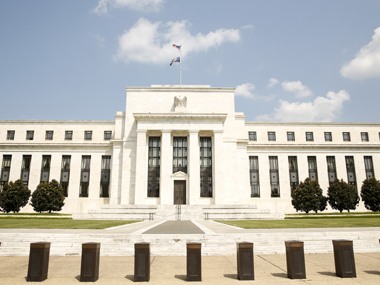“It is very difficult to read a woman’s mind,” a friend said a few days back, when I told him that Janet Yellen, the current Chair of the Federal Reserve of the United States, the American central bank, will raise interest rates at the end of the meeting of the Federal Open Market Committee (FOMC), scheduled on 15-16 December 2015. FOMC is a committee within the Federal Reserve which runs the monetary policy of the United States. The Yellen-led FOMC raised the federal funds rate by 25 basis points (one basis point is one hundredth of a percentage) to be in the range of 0.25-0.5%. Earlier, the federal funds rate moved in the range of 0-0.25%. The federal funds rate is the interest rate at which one bank lends funds maintained at the Federal Reserve to another bank on an overnight basis. It acts as a sort of a benchmark for the interest rates that banks charge on their short and medium term loans. [caption id=“attachment_2549584” align=“alignleft” width=“380”]  US Fed building. Reuters[/caption] In this case, it wasn’t very difficult to read a woman’s mind simply because she had more or less made it clear in a speech she gave earlier this month that the Federal Reserve will raise interest rates when the FOMC met later this month. As she had said: “That initial rate increase would reflect the Committee’s judgment, based on a range of indicators, that the economy would continue to grow at a pace sufficient to generate further labour market improvement and a return of inflation to 2 percent, even after the reduction in policy accommodation. As I have already noted, I currently judge that US economic growth is likely to be sufficient over the next year or two to result in further improvement in the labour market.” This is the closest any central banker governor could have come to say that “I am ready to raise interest rates”. The Federal Reserve has a dual mandate — price stability and maximum employment. How is the American economy doing on these two fronts? The rate of unemployment in the United States stood at 5% of the labour force in November 2015. It has halved from October 2009, more than six years earlier, when it was at 10%. While this shows a significant improvement, there is something that this number does not reveal. Many Americans have simply stopped looking for jobs because they can’t find one. This means they have dropped out of the labour force and hence are not measured as a part of the unemployment number. This is reflected in the employment to population ratio. In January 2007, when the current financial crisis was brewing up and hadn’t really set in with full force, the ratio was at 63.3%. It has since then fallen dramatically and currently stands at 59.3%, as of November 2015. This ratio has improved from October 2013, when it stood at 58.2%, it is still way beyond where it was before the financial crisis started. How do things stand on the inflation front? The Federal Reserve works with an inflation target of 2%. The consumer price index in the United States over the last one year has risen by just 0.5%. This is way lower than the Federal Reserve’s target of 2%. Yellen blamed this low inflation on low oil prices as well as a strong dollar. A strong dollar has led to imports becoming cheaper and this has had led to lower inflation. As Yellen said in her speech earlier this month: “Because food and energy prices are volatile, it is often helpful to look at inflation excluding those two categories–known as core inflation…But core inflation–which ran at 1-1/4 percent over the 12 months ending in October–is also well below our 2 percent objective, partly reflecting the appreciation of the U.S. dollar. The stronger dollar has pushed down the prices of imported goods, placing temporary downward pressure on core inflation…Taking account of these effects, which may be holding down core inflation by around 1/4 to 1/2 percentage point, it appears that the underlying rate of inflation in the United States has been running in the vicinity of 1-1/2 to 1-3/4 percent.” So what Yellen is effectively saying is that if conditions were normal then rate of inflation would be close to 1.5-1.75% and not 0.5%, as it is. And that is why she has raised the federal funds rate. But the point is that conditions are not normal. They haven’t been normal since September 2008, when Lehman Brothers, the fourth largest investment bank on Wall Street went bust. If we go by the dual mandate that the Federal Reserve has of maximum employment and price stability, then the FOMC should not have raised the federal funds rate. It still did. Why? Yellen explained this by saying: “Were the FOMC to delay the start of policy normalisation for too long, we would likely end up having to tighten policy relatively abruptly to keep the economy from significantly overshooting both of our goals. Such an abrupt tightening would risk disrupting financial markets and perhaps even inadvertently push the economy into recession.” What does this mean in simple English? The Federal Reserve has kept interest rates low in the aftermath of the financial crisis. In fact, this has gone on for close to seven years now. The American central bank has also printed and pumped money into the financial system, in the hope of corporates and consumers borrowing and spending more. The hope was that this spending will eventually lead to an economic recovery, which it has to some extent. Nevertheless, there is way too much money floating around in the financial system and the fear is that it will eventually cause inflation. Of course, it hasn’t caused inflation up until now. But that doesn’t mean that what hasn’t happened up until now cannot happen in the future. Economic history is littered with examples which show that a sustained easy money policy being run by central banks never ends well. As Albert Edwards of Societe Generale wrote in a research note few years back: “[The] assertion that because the quantitative easing [another term for money printing carried out by central banks] to date has not yet produced rapid inflation must mean that it will never produce rapid inflation is just plain wrong.” Nassim Nicholas Taleb is a lot more direct in Anti Fragile when he says “central banks can print money; they print print and print with no effect (and claim the “safety” of such a measure), then, “unexpectedly,” the printing causes a jump in inflation.” Just because something hasn’t happened in the recent past does not mean it won’t happen in the future. Yellen and the Federal Reserve finally seem to be coming around the idea. An easy money policy cannot be run forever. One day it has to come to an end. The question is whether the American economy is in a position to be able to withstand this interest rate hike and further hikes in the coming months. I have my doubts on that. Watch this space. (Vivek Kaul is the author of the Easy Money trilogy. He tweets @kaul_vivek)
“It is very difficult to read a woman’s mind,” a friend said a few days back, when I told him that Janet Yellen, the current Chair of the Federal Reserve of the United States, the American central bank, will raise interest rates at the end of the meeting of the Federal Open Market Committee (FOMC), scheduled on 15-16 December 2015. FOMC is a committee within the Federal Reserve which runs the monetary policy of the United States.
Advertisement
End of Article


)

)
)
)
)
)
)
)
)



